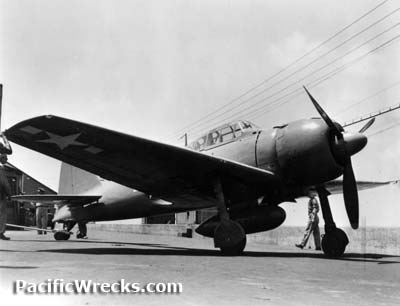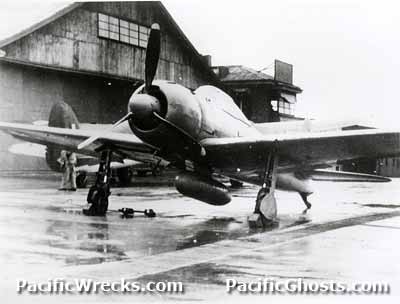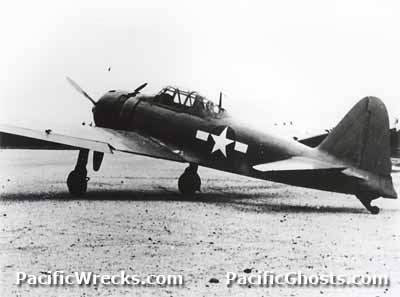|
|
|
|
| Missing In Action (MIA) | Prisoners Of War (POW) | Unexploded Ordnance (UXO) |
| Chronology | Locations | Aircraft | Ships | Submit Info | How You Can Help | Donate |
|
| USAAF Former Assignments IJN    

USAAF 1943 |
Aircraft History This aircraft was a hybrid assembled by Allied personnel from the wreckage of at multiple Zeros captured at Buna Airfield during late December 1942 to early January 1943. The captured Zeros were loaded aboard a barge and shipped to Brisbane then transported to Eagle Farm Field. At Eagle Farm Airfield, this A6M3 Zero Model 32 was reconstructed by Allied personnel from Allied Techincal Intelligence Unit (ATIU) as a hybrid from parts of multiple aircraft. Major components from at least three Zeros from Buna Airfield were used including the engine from A6M3 Zero 3028, the main fuselage and wings from A6M3 Zero 3030 and the rear fuselage and other components from A6M3 Zero 3032. Additional parts were used from two other Zeros captured at Buna Airfield. The cockpit canopy was from A6M2 Zero 5349. At least one drop tank was repaired and available for testing. The Zero was painted overall gray with a black engine cowling and painted with U.S. star insignia. Later painted with Japanese Hinomaru (Rising Sun) insigina for flight testing and photography to create accurate images for Allied training materials. Later was painted with a U.S. star and bar insignia. Administratively designated XJ001 but never applied to the plane. When the Zero neared completion, a Japanese Zero pilot Prisoner Of War (POW), (likely Sea1c Katsuro Nagatomo) help ATIU create a cockpit check list with the aid of an interpreter. On July 20, 1943 this Zero hybrid took off piloted by Captain William O. Farrior on its first test flight for 30 minutes. No problems were encountered and no major adjustments were needed except for some trim adjustments. On July 21, 1943 the rebuilt Zero took off piloted by Captain William O. Farrior on its second test flight on another 30 minute test flight, but the engine cut out due to carburettor problems forcing him to make a dead stick landing. Afterwards, the right landing gear was repaired, but this Zero still had a tendency to ground loop, but this time in the opposite direction, so a tail wheel lock was installed to fix the problem. The brakes proved to be very inferior despite numerous relining, adjustment and checking of the system. As a result, all pilots were ordered not to use the brakes except during an extreme emergency. After the repairs, test pilot Captain William O. Farrior made additional flights. On July 27, 1943 for 40 minutes, August 6, 1943 for 2.3 hours, August 10, 1943 for one hour, August 11 , 1943 for 30 minutes, August 13, 1943 for 1 hour 5 minutes, August 21, 1943 for 2.5 hours, August 23, 1943 for 2.5 hours. On September 1, 1943 flown for 1.3 hours, September 2, 1943 for 2.1 hours and September 8, 1943 for 4.5 hours. In total, Farrior flew this Zero for 20 hours and 45 minutes. Later, this aircraft was disassembled and shipped to the United States for further testing by the U.S. Army Air Force (USAAF) at Wright Field and later Eglin Field. In the United States tail code EB-201 was painted in black on both sides of the tail. Richard Dunn adds: "Hamp EB-201 arrived at Wright Field with 69 hours and had flown 22 hours since arrived (91 total). A later report (29 April 1944) from Eglin Field shows they were attempting to fly the HAMP against the P-47 for comparison. However, scored piston walls, bent plugs indicated a new engine was needed. A 10 May 44 report says new cylinders and pistons installed but they were encountering trouble with the prop governor. The last data I have indicates they were still working on the a/c on 13 May 44." The ultimate fate of this Zero is unknown. Likely scrapped or otherwise disappeared at the end of the war or after testing was completed. References Individual Flight Record of Captain William Owen Farrior July 1943 via Owen Farrior (son) Hand written flight records of Captain William Owen Farrior flying captured Japanese aircraft via Owen Farrior (son) Oz@War "Crash Landing of a Type 0, Mk 2 SSF "Hap" (Zero) Japanese Fighter Aircraft at Eagle Farm Airfield Brisbane, QLD on 21 July 1943" Technial Intelligence Report No. 163 Thanks to Richard Dunn and Peter Dunn for additional information Contribute
Information Last Updated
|
Photo Archive |
| Discussion Forum | Daily Updates | Reviews | Museums | Interviews & Oral Histories |
|